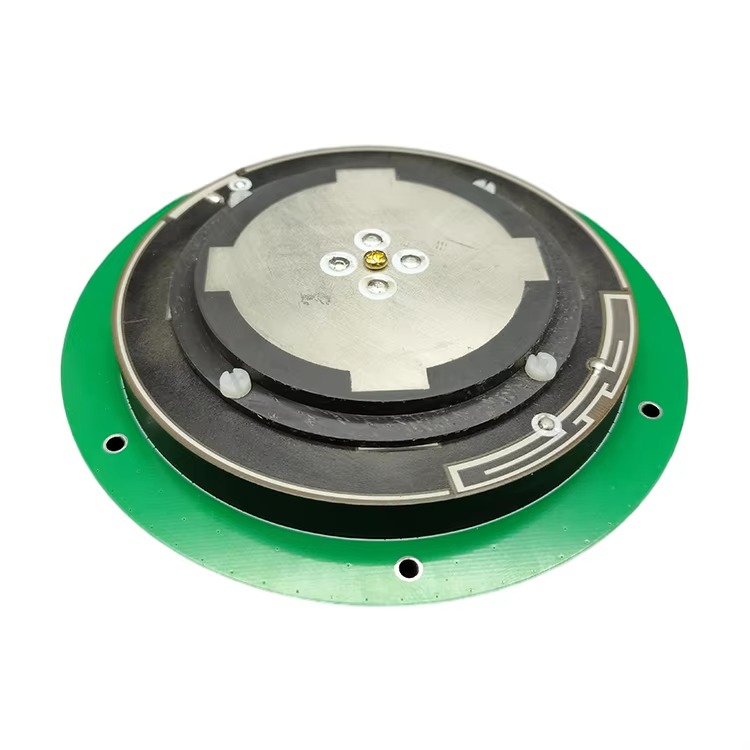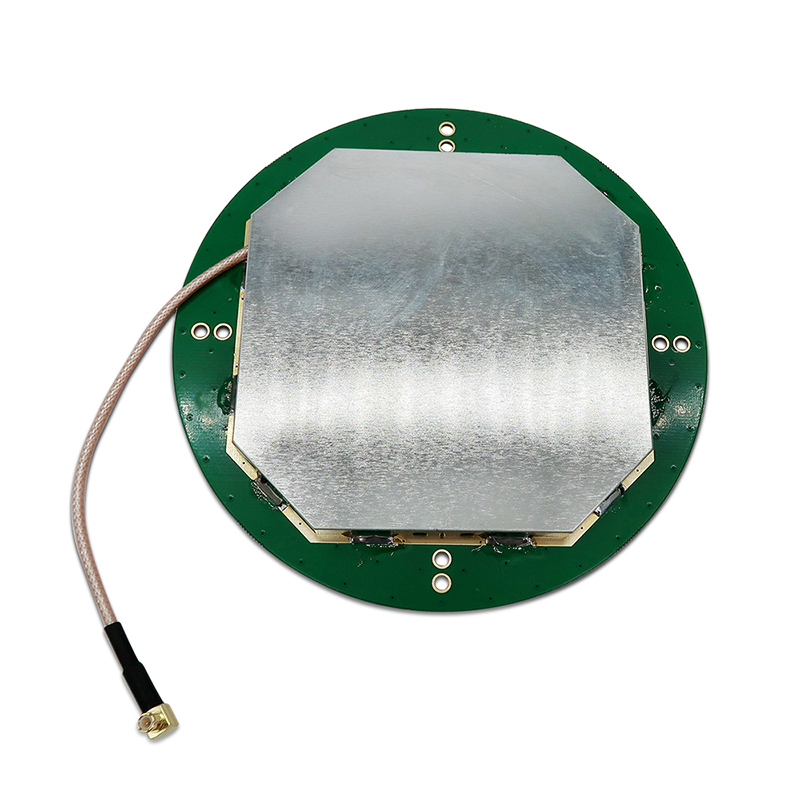The multi-system RTK antenna is the linchpin of a vast array of precision agricultural applications, transforming how farmers manage every stage of the crop cycle. Its ability to provide continuous, centimeter-accurate positioning has moved far beyond simple auto-steer, becoming integrated into the very fabric of data-driven farm management. As technology evolves, its role is expanding into even more sophisticated and autonomous applications.
Applications
Automated Guidance and Steering: This is the most widespread and foundational application. RTK guidance is used for:
Tillage: Precisely aligning passes to avoid compaction and ensure uniform seedbed preparation.
Planting: Ensuring straight rows and precise seed placement. This is critical for subsequent mechanical cultivation and for maximizing yield per acre.
Spraying: Eliminating overlap is crucial here to prevent crop damage from over-application of herbicides and to reduce chemical costs and environmental impact.
Harvesting: Guiding combines to efficiently harvest every inch of the crop and to ensure the header follows ground contours for optimal cutting height.
Controlled Traffic Farming (CTF): This is a systems-level approach enabled entirely by RTK accuracy. All machinery is equipped with compatible RTK systems and uses the same guidance lines. This permanently confines wheel traffic to specific lanes, leaving the majority of the field soil uncompacted. The benefits are profound: improved soil structure, enhanced water infiltration and retention, better root growth, and ultimately, higher yields.
Variable Rate Application (VRA): RTK positioning provides the "where" for VRA. The guidance system triggers a controller to change application rates on-the-go based on a georeferenced prescription map. This allows for:
Variable Rate Seeding: Planting more seeds in high-yielding zones of a field and fewer in low-yielding zones.
Variable Rate Fertilizer: Applying nutrients only where they are needed, as indicated by soil or yield maps.
Variable Rate Irrigation: Controlling center pivots or other systems to apply different amounts of water to different areas.
High-Resolution Field Mapping: RTK is used to create accurate maps for:
Yield Mapping: Correlating harvest data with precise location to create a map of spatial yield variability, the most important data layer for making informed management decisions.
Soil Sampling: Guiding a sampler to take samples from precise, pre-determined locations within a field, leading to more accurate soil nutrient maps.
Scouting and Problem Mapping: Pinpointing the location of weed outbreaks, disease patches, or drainage issues for targeted remedial action.
Implement Control and Automation: Beyond steering the tractor, RTK data is used to control implements:
Section Control: Automatically turning off individual sections of a planter, sprayer, or fertilizer spreader on headlands and point rows to prevent overlap and double-application. This is a major source of input savings.
Height Control: Using the precise position and elevation data to automatically raise and lower implements (e.g., a planter row unit) to maintain perfect depth control in rolling fields.
Future Trends
The future of multi-system RTK in agriculture is one of deeper integration, greater autonomy, and enhanced resilience.
Full System Integration and "Plug-and-Play": Future systems will move towards seamless interoperability between different brands of tractors, implements, and controllers using standards like ISOBUS. The RTK antenna will simply be a sensor on a common network, making it easier to deploy and use.
The Path to Full Autonomy: RTK is the cornerstone of agricultural autonomy. Driverless tractors and implements rely on its centimeter-level accuracy for safe and effective navigation. Future trends will see RTK fused with other sensors like LiDAR, cameras, and radar to create a robust perception system that can navigate around obstacles while maintaining precise positioning within the crop rows.
Enhanced Correction Services and PPP-RTK: The future lies in advanced correction services that blend the benefits of public base station networks with precise point positioning (PPP) techniques. PPP-RTK can deliver near-RTK accuracy over vast areas without the need for a local base station, reducing the cost and complexity for farmers while maintaining high accuracy.
Multi-Band Becomes Standard: Support for the modern L5/E5/B2a signals will become standard. These signals are stronger, have higher power, and are more robust against interference and multipath, leading to even faster convergence times and improved reliability under challenging conditions like partial canopy cover.
Miniaturization and Lower Cost: As technology advances, the cost of high-performance RTK systems will continue to fall, and the form factors will become smaller and less obtrusive. This will open up the technology to smaller farms and for use on smaller equipment, such as utility vehicles and specialized robotic platforms.
AI and Predictive Guidance: Machine learning algorithms will use historical RTK path data, yield maps, and soil data to not just guide a tractor on a straight line, but to predict the optimal path through a field to maximize efficiency, minimize compaction, and avoid known wet spots or areas of low productivity.
The multi-system RTK antenna will remain the bedrock of precision positioning. Its evolution will be towards being a more intelligent, connected, and resilient component within a larger ecosystem of automated and data-driven farming systems, pushing the boundaries of agricultural efficiency and sustainability further than ever before.
Conclusion
The multi-system RTK antenna is far more than a simple component on the roof of a tractor; it is the fundamental enabler of the precision agriculture revolution. It represents the critical convergence of advanced satellite technology, sophisticated RF engineering, and rugged industrial design, all focused on solving a single, vital problem for modern farmers: knowing exactly "where" with unwavering certainty. This capability has ceased to be a luxury and has become a cornerstone of efficient, profitable, and sustainable food production.
Its design philosophy is one of uncompromising precision. From the stacked-patch element that harvests signals from every available satellite constellation and frequency band, to the stable substrate that ensures a rock-solid phase center, to the integrated LNA that preserves signal integrity—every aspect is engineered to deliver the cleanest possible carrier-phase measurements. This relentless focus on data quality at the point of capture is what allows the complex RTK algorithm to perform its magic, resolving integer ambiguities in seconds and maintaining a continuous centimeter-accurate fix even on rolling terrain under a partially obscured sky.
The advantages it delivers are transformative and quantifiable. The elimination of overlap and skip directly translates into massive savings on expensive inputs like seed, fertilizer, and chemicals. The ability to work effectively in low-visibility conditions extends valuable working windows. The reduction in operator fatigue improves safety and work quality. Most importantly, the enablement of practices like Controlled Traffic Farming and high-resolution mapping fosters long-term soil health and provides the data needed for truly informed decision-making, season after season.
While challenges exist—primarily the initial investment and the need for system management—they are far outweighed by the return on investment and the strategic advantages gained. The multi-system capability has been the key to overcoming the reliability issues that plagued earlier systems, making RTK a robust and trustworthy technology that farmers can depend on for their daily operations.
Looking forward, the role of this antenna is only set to deepen. It is the essential sensor upon which the entire edifice of agricultural autonomy will be built. It will evolve from providing mere position to being an intelligent node in an integrated network, contributing to AI-driven path planning and seamless implement control. As correction services improve and costs decrease, its benefits will become accessible to an ever-wider range of farmers across the globe.
In conclusion, the multi-system RTK antenna is a testament to the power of targeted technological innovation. It is a tool that has fundamentally changed the practice of farming, moving it from an art form based on intuition to a science driven by data. By providing the absolute reference of position, it has brought a new level of control, efficiency, and intelligence to the ancient practice of working the land, ensuring that we can meet the future's food production challenges with precision and confidence.




































































 Language
Language
 En
En Cn
Cn Korean
Korean

 Home >
Home > 






 18665803017 (Macro)
18665803017 (Macro)













